
|
The TCON-30C Lens Attachment for the Olympus C-5060WZ and C-7070WZ cameras |

| My other pages related to the Olympus C-5050Z, C-5060WZ, and X-7070WZ |
This review is another co-operative effort, written together with Thomas B. from Sweden, who is also the author of all pictures shown here.
|
| The C-5060WZ and C-7070WZ are ambitious cameras, providing the user with almost all amenities of SLRs, except for two (most important) things: optical through-the-lens viewing and interchangeable lenses. To address the later limitation, Olympus released two lens attachments, changing the focal length of the built-in camera lens: WCON-07C and TCON-17C (wide-angle and tele, respectively). This year, they have added another one, nicely rounding up the system. The new auxiliary lens, TCON-30C provides a nominal 3x focal length multiplier, raising the effective maximum focal length to 330 mm, which is probably as far as I would dare to go without a tripod. There are no meaningful Web postings on the TCON-30C, and the few we could find are misleading and erroneous in a number of places. This brief user report is intended to fill that gap.
Here is TCON-30C, with it lens hood and rear cap on, the push-on lens cap also shown.
|
| 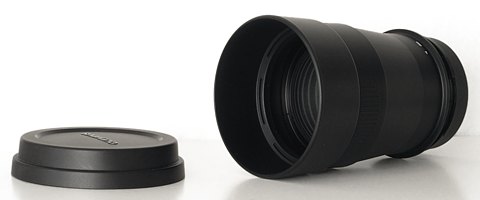
| Specifications The technical specifications are quoted after Olympus promotional information; some of them will be further discussed, refined, and/or corrected in the text of the article.
In the box Thomas: What you get in the package is the TCON-30C with a screw-on hood, front and back caps, and a storage pouch. The pouch takes the lens with mounted hood and caps (total length of 125 mm). What seems annoying is that the front cap adds almost another 1 cm to the length; however, it has a dual purpose, fitting on the lens with the hood on or off.
| |||
| You may remove the hood and put it loosely over the back of the lens; the total length shrinks then to only 88 mm, and in this configuration the front cap does not add much to the length; the pouch can accommodate both the lens and the CLA-7 adapter. |
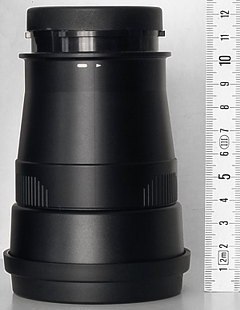
|
To make the comparison easier, both pictures are resized to the same scale. If the diameter may seem a bit different, it's just an optical illusion. |
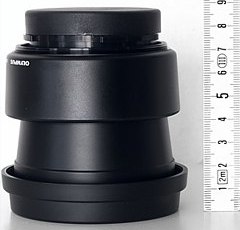
| ||
|
Andrzej: I'm not sure how Olympus arrived to the 108 mm length value. Thomas: This probably refers to the lens with the hood on, but without the lens caps. Andrzej: I would think so. Also, the quoted lens length often excludes the protrusions beyond the rear flange. Thomas: The pouch is not really that useful, it's OK for storage at home, or to be thrown in a larger bag. It can't be attached easily to a camera bag, and it is not sturdy enough to be carried by itself. Andrzej: The push-on rear cap is of the same, cheap and unreliable, type as those in the other TCON-C converters. With not enough friction grip, it often does not stay on when you put the lens into your bag. A very unsatisfactory solution, saving Olympus maybe 25 cents on a $200 product. Boo. On the positive side, I'm glad to see that the lens accepts filters. This was missing in the previous TCONs. The 67 mm filter thread is not prohibitively large, which means that the filter price will stay within reasonable limits. | ||
|
Mounting on the camera Andrzej: To mount TCON-30C on your C-5060/7070WZ camera (it will not work on any other), you have to use the CLA-7 lens adapter, introduced for the '5060. The adapter is made of plastic (except for the front, tightening ring), has a non-standard 48.5 mm male thread in the back, and a proprietary bayonet on the front. The thread goes into a female one surrounding the lens base, and the bayonet accepts the matching one on the lens attachment. I've already voiced my dissatisfaction with this solution in my previous lens attachment article, so I'm not going to repeat myself here. Thomas: Despite Andrzej's misgivings, the design probably has its reasons. One may be that the two-step mechanism of attaching a lens gives a good, snug fit, I think, without wearing out the bayonet. I agree that taking the lens off is a bit inconvenient. I found that you have to hold the adapter (since it does unscrew easily at the back) with one hand, and with the other hold the lens and turn it all the way until all three markers line up, before removing it. (The lens could be removed before all marks line up, but then you would have to adjust it later.) Andrzej: If I had three hands, I would have found this procedure quite OK. Anyway, for a relatively big attachment like this one, the bayonet bulk may be not so bad as for the smaller ones. Still, I stick to my original opinion. | |
|
Thomas: This is the TCON-30C mounted on my C-5060WZ with the CLA-7 tube.
It was a tricky picture, being a self-portrait of the camera, taken with use of two mirrors, and with an off-camera Vivitar flash (the contraption mounted in the camera's hot shoe is the flash sensor). Andrzej: I admit, I've played with this image a bit in the Photo-Paint... |
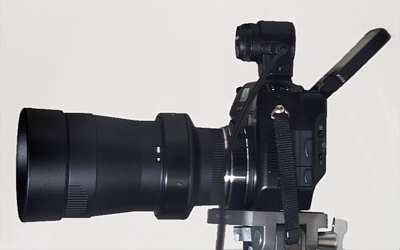
|
|
Thomas: As you can see, the whole outfit is rather compact; it feels light on the camera, and there are no problems with operating it. Andrzej: Indeed, getting a 300 mm EFL at the extra weight of just 250 g (including adapter) is a bargain. You have to remember, though, that your optical viewfinder becomes useless with the attachment; you have to use the LCD monitor. Now, handholding a long lens against your head is much easier than doing it with outstretched hands. I wish Olympus provided etched frames in the viewfinder for their 1.7x and 3x attachments — after all, they locked (almost) the independent makers out of the market... A small thing and a big difference. To follow recommended procedures, when using TCON-30C or other lens attachments, you should set the Accessory option in the Camera menu to ON, to disable the external, passive autofocus system (obstructed by the lens attachment). In the past, I forgot many times to do it, without noticeable adverse effects. Thomas: Any filter on the camera's lens bumps into the innermost ring of the CLA-7, and the camera will refuse to work. You have to remove the filter before putting the lens adapter on. Andrzej: This is normal. Many attachments are designed to be as close to the lens as possible. Optical Andrzej: Six glass elements used in this lens means that this is not a cheapo solution, in spite of the plastic barrel construction. The lens is multicoated (externally at least). | |
|
Thomas: The exit pupil on the back side of the lens is quite tiny. I guess the point was to keep the lens light, allowing only taking pictures at the max tele position. I have used lens converters in the past, and they used to work over the whole zoom range (on Super-8 film cameras). |
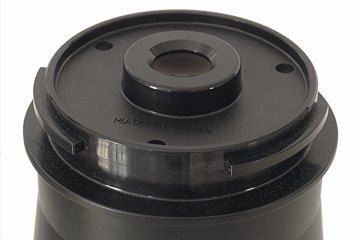
|
|
Andrzej: With frame size greater than that in 8-mm movie film, converters for still cameras are designed to work at one or the other end of the zoom range. Small-format movie (or video) cameras are not as demanding on image quality as still ones; that's why many video lens converters, often sold for still cameras, perform so poorly. In case of tele attachments it is sufficient if the exit pupil matches the size of the main lens front element, and that element is quite small in the not-so-bright lens on the '5060/7070. The TCON-17C is built in a very similar way. Thomas: As far as I can tell, the this adapter does not reduce the F-stop of the main lens, so you are still getting F/4.8 at the lens zoomed all the way out. Andrzej: This is almost always true in case of front-end converters. Roughly speaking, a 3x attachment has to have the front element of three times the diameter of the main lens. If it is smaller, it will usually lead to vignetting. Thomas: According to my calculations, based on two pictures shot from the same spot (but without a tripod), the focal length multiplier is not 3.0, but 2.9. Andrzej: My measurements show the same: 2.89±.01. This means that the effective EFL of the combination is not 330, but 319 mm — hardly a significant difference. Usually lens makers stay within a 5% tolerance in marking their lenses. Thomas: I was able to zoom out by up to 15% without vignetting visible in the corners. This would mean the effective EFL range of approximately 270-320 mm. Andrzej: The samples seem to indicate that. At smaller apertures (greater F-numbers) you might get away with somewhat shorter focal lengths, but not by much. Anyway, with the imprecise, lever-driven zoom in the '5060/7070 I would stay at the maximum anyway, as vignetting may be hard to spot on the LCD screen, becoming clearly visible only after the fact, when it is too late. Image samples Thomas: The samples were shot handheld, but under conditions bright enough for handholding. Andrzej: In the exposure data, extracted from the EXIF information, the EFL was given with use of the actual conversion ratio of 2.9 (not the nominal 3.0x). Note that the first image with the converter was zoomed out a little bit (the main lens was at F = 19.5 mm, not the maximum of 22.9 mm. | |
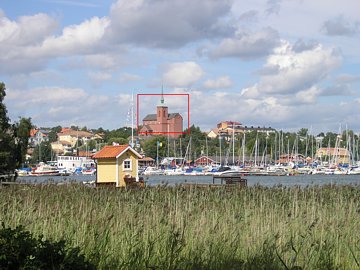
|

| |
| Without TCON: EFL = 110 mm, program exposure at F/5.6 and 1/500 s, ISO 80, handheld. White balance at auto; sharpness, contrast and saturation at default. | Central sample from the image at the left | |
-r.jpg)
|
-f.jpg)
| |
| With TCON-30C: EFL = 272 mm (zoomed out a bit), all other parameters exactly as above. | Central sample from the image at the left |
|
Andrzej: The central resolution of the lens combination is very good, indeed; I would say better than in many "super-zooms" in EVF cameras, set to the same focal length. Now another sample, to have a look at both the central and corner resolution. |
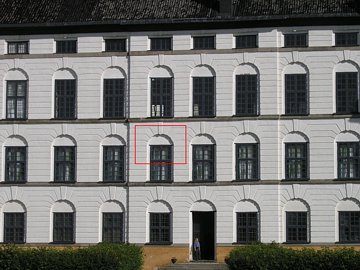
|
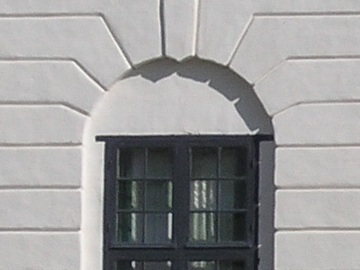
|
| Without TCON: EFL = 110 mm, program exposure at F/6.7 and 1/750 s, ISO 80, handheld. White balance at auto; sharpness, contrast and saturation at default. | Central sample from the image at the left |
-r.jpg)
|
-f1.jpg)
|
| With TCON-30C: EFL = 319 mm, program exposure at F/6.7 and 1/500 s, ISO 80; other settings at above | Central sample from the image at the left; just dandy. |
|
Andrzej: Clearly, a significant loss of sharpness and contrast in the corners, but I am not sure how much of this is caused by the main lens: I was able to see a similar effect in samples shot without the TCON, at the longest setting of the zoom.
I don't think this amount would be objectionable in most applications; if you want to avoid it, shoot in aperture priority, stepping the lens down to F/8. Overall, I consider this a respectable performance for an attachment lens. |
-f2.jpg)
|
| Corner sample from the image at the top left. Eh-hem... | |
-r.jpg)
|
Thomas: Another example, showing that sometimes it would be useful to have a bit of zooming possibility. Here the boat would not fit into the frame at full zoom, so I had to zoom out a bit, at the expense of vignetting.
Andrzej: Note that the zoom was only at 78% of the maximum focal length, way below the 85% limit we consider safe for this combination. |
| TCON-30C, main lens at F = 17.8 mm (combined EFL = 248 mm). Program exposure: 1/350 s at F/5.6, ISO 80; all other settings at defaults. Original frame reduced and re-sharpened. |
|
Conclusions Thomas: The lens handles very well, so it is really a useful addition to my camera bag (I don't have the other converter lenses), and the pictures have turned out quite nice. At the edges, the resolution of the lens is somewhat lower, but at 300 mm, the focus of attention is usually the center. I think TCON-30C does quite a good job. Andrzej: Indeed, based on the samples I went through, the attachment performs nicely. Loss of sharpness in the outer regions can be forgiven or remedied with stepping the lens down to F/8 (the '7070 goes all the way down to F/11). At the weight of only 200 g, the becomes a great accessory when traveling light: I could fit my '5060 together with WCON-07C, TCON-17C, and TCON-30C into a small bag for a hike, throwing in the FL-36 flash unit just in case. I believe the pricing is way too high. Clearly, Olympus is playing to a captive audience here. For the same money you can buy a Sigma tele zoom lens for the E-1/E-300 (or some other digital SLR), with the whole aperture and focus mechanism, more glass, computer chip communicating with the camera, and more. Clearly, not a plastic attachment without any moving parts. I believe that while milking the confined market may be profitable in the short run, it will not help Olympus to build a following. Still, while for long-lens shooting I'm using an E-300 with either Olympus 40-150 mm or the Sigma 55-200 mm zoom (maximum EFL of 300 or 400 mm, respectively), I'm tempted to get a TCON-30C for the '5060, used a lot by my wife, who starts complaining that the TCON-17C is not long enough for her wildlife photography attempts. |

| My other pages related to the Olympus C-5050Z, C-5060WZ, and X-7070WZ |
| Home: wrotniak.net | Search this site | Change font size |
| Posted 2005/09/06; last updated 2006/03/05 | Copyright © 2002-2006 by J. Andrzej Wrotniak and Thomas B. |